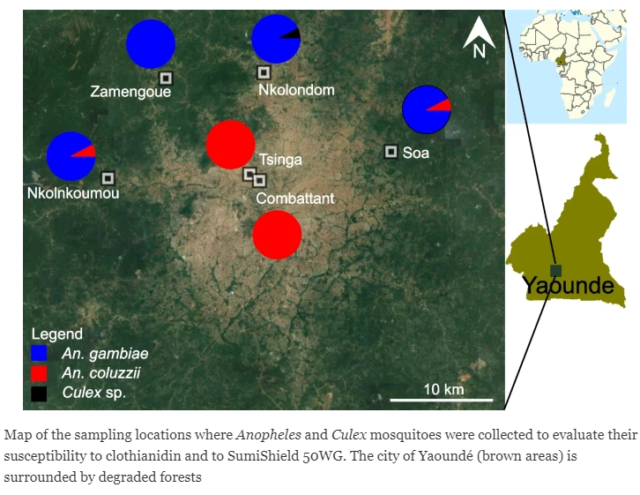 In this study, we used standard bioassay to evaluate the efficacy of clothianidin (CDC bottle bioassay), and the SumiShield 50WG formulation (WHO tube test) against Anopheles and Culex population within and around Yaoundé, the capital city of Cameroon. We tested mosquitoes from two urban sires (Combattant, Tsinga) at Yaounde, and four sub-urban (Nkolondom, Zemengoue, Nkolnkoumou and Soa). Laboratory strains An. gambiae, Kisumu and An. coluzzii, Ngousso were used as susceptible control populations.
In this study, we used standard bioassay to evaluate the efficacy of clothianidin (CDC bottle bioassay), and the SumiShield 50WG formulation (WHO tube test) against Anopheles and Culex population within and around Yaoundé, the capital city of Cameroon. We tested mosquitoes from two urban sires (Combattant, Tsinga) at Yaounde, and four sub-urban (Nkolondom, Zemengoue, Nkolnkoumou and Soa). Laboratory strains An. gambiae, Kisumu and An. coluzzii, Ngousso were used as susceptible control populations.
Our results revealed that the test procedure was reliable as laboratory strains had a mortality of 100% after 24 hours post exposure. We were able to see that An. coluzzii predominantly present in the urbanized sites and Culex present in farm lands were susceptible to both clothianidin and SumiShield 50WG though 100% mortality was only achieved between two and four days with the An. coluzzii population. However, An. gambiae population exhibited resistance to both clothianidin (58.2 ± 5.2% mortality) and SumiShield 50WG (75.4 ± 3.5%). This indicates that resistance to clothianidin is probably species dependent. A proper investigation by population, revealed a resistance gradient with mosquito populations from Nkolondom (an agricultural site where a survey revealed the intense use of insecticides by farmer for crop cultivation) being the most resistant (46.5 ± 5.7% mortality) and those from Combatant and Tsinga (both urban site at the city center) being the most susceptible (100% mortality) with Nkolnkoumou being intermediate suggesting the implication of agricultural pesticide in the selection for insecticide resistance.
These findings suggest that prior to inclusion of agrochemicals in resistance management programs, variation in susceptibility among vector species as well as cross-resistance due to residual pesticide exposure and/or to the ubiquitous activity of some detoxification enzymes should be particularly scrutinized.
Read more: https://bmcinfectdis.biomedcentral.com/articles/10.1186/s12879-024-09030-8






